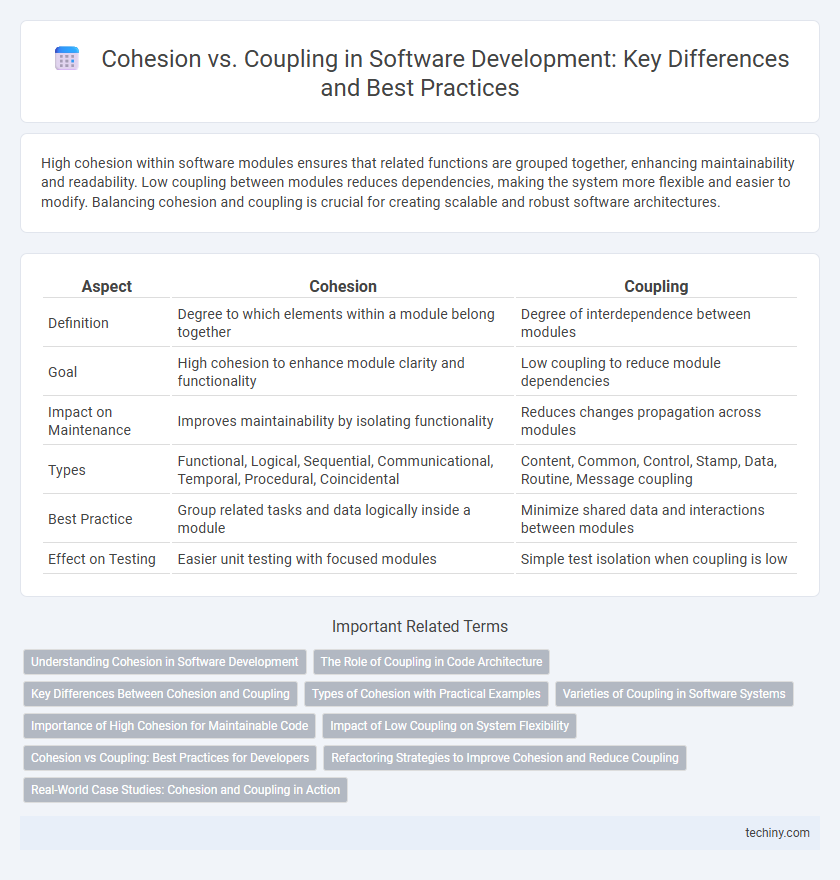High cohesion within software modules ensures that related functions are grouped together, enhancing maintainability and readability. Low coupling between modules reduces dependencies, making the system more flexible and easier to modify. Balancing cohesion and coupling is crucial for creating scalable and robust software architectures.
Table of Comparison
| Aspect | Cohesion | Coupling |
|---|---|---|
| Definition | Degree to which elements within a module belong together | Degree of interdependence between modules |
| Goal | High cohesion to enhance module clarity and functionality | Low coupling to reduce module dependencies |
| Impact on Maintenance | Improves maintainability by isolating functionality | Reduces changes propagation across modules |
| Types | Functional, Logical, Sequential, Communicational, Temporal, Procedural, Coincidental | Content, Common, Control, Stamp, Data, Routine, Message coupling |
| Best Practice | Group related tasks and data logically inside a module | Minimize shared data and interactions between modules |
| Effect on Testing | Easier unit testing with focused modules | Simple test isolation when coupling is low |
Understanding Cohesion in Software Development
Cohesion in software development measures how closely related the functions within a single module are, promoting maintainability and clarity by ensuring each module serves a specific purpose. High cohesion reduces complexity, making the code easier to debug and extend by logically grouping related tasks and responsibilities. Emphasizing strong cohesion improves software quality and supports modular design principles essential for scalable and robust applications.
The Role of Coupling in Code Architecture
Coupling in code architecture measures the degree of interdependence between software modules, where low coupling enhances modularity and maintainability by minimizing the impact of changes across components. High coupling often leads to rigid systems that are difficult to test, debug, and extend, increasing the risk of cascading failures. Effective software design prioritizes loose coupling to promote scalability, improve code reuse, and facilitate parallel development workflows.
Key Differences Between Cohesion and Coupling
Cohesion refers to the degree to which elements within a module belong together, promoting high internal consistency, while coupling measures the interdependence between different modules, with low coupling being ideal. High cohesion improves module maintainability and readability by ensuring that a module has a single, well-defined purpose, whereas low coupling reduces the risk of changes in one module impacting others, enhancing system modularity. Effective software design balances high cohesion with low coupling to achieve scalable, flexible, and robust code architecture.
Types of Cohesion with Practical Examples
Functional cohesion represents modules performing a single, well-defined task, such as a function that calculates tax based on input values. Sequential cohesion occurs when one module's output forms the input for another, like a data processing pipeline transforming raw data into reports. Communicational cohesion involves modules operating on the same data set, exemplified by CRUD operations within a database access class.
Varieties of Coupling in Software Systems
Varieties of coupling in software systems include content coupling, where one module directly modifies the data of another; common coupling, characterized by shared global data accessible by multiple modules; control coupling, involving one module controlling the behavior of another through flags or parameters; stamp coupling, which passes composite data structures between modules; and data coupling, the loosest form, where only necessary data is passed through parameters. High data coupling supports modular design by minimizing dependencies, while stronger coupling types like content or common coupling reduce system maintainability and scalability. Understanding and minimizing tight coupling is crucial in software architecture to enhance code reuse, testability, and parallel development.
Importance of High Cohesion for Maintainable Code
High cohesion in software development ensures that a module or class has a single, well-defined purpose, which simplifies understanding and reduces the complexity of maintenance. Modules with high cohesion enable easier debugging, testing, and enhancement by keeping related functionalities tightly integrated and minimizing dependencies. This leads to more maintainable codebases, improved code readability, and faster adaptation to changing requirements, critical for long-term software project success.
Impact of Low Coupling on System Flexibility
Low coupling in software development significantly enhances system flexibility by allowing individual modules to be modified, replaced, or updated independently without affecting others. This separation reduces dependency constraints, facilitating easier maintenance, scalability, and integration of new features. Systems designed with low coupling are more adaptable to changing requirements and technological advancements.
Cohesion vs Coupling: Best Practices for Developers
High cohesion within software modules enhances maintainability and readability by ensuring that components have a single, well-defined purpose. Low coupling between modules minimizes dependencies, enabling easier modifications and promoting reuse of code across different projects. Developers should strive to design cohesive modules with clear interfaces while keeping coupling loose to foster scalable and flexible software architectures.
Refactoring Strategies to Improve Cohesion and Reduce Coupling
Refactoring strategies to improve cohesion involve decomposing large classes or methods into smaller, well-defined units that encapsulate a single responsibility, enhancing modularity and maintainability. Techniques such as extracting methods, creating utility classes, and applying the Single Responsibility Principle help achieve high cohesion, making the codebase easier to understand and modify. Reducing coupling is addressed by introducing interfaces, dependency injection, and using design patterns like Observer or Mediator, which minimize dependencies between modules and promote loose coupling for flexible and scalable software architecture.
Real-World Case Studies: Cohesion and Coupling in Action
Real-world software projects reveal that high cohesion within modules enhances maintainability by grouping related functionalities, as seen in microservices architectures where services perform distinct tasks efficiently. Low coupling between components reduces dependencies, enabling teams to develop, test, and deploy modules independently, exemplified by modular monoliths in enterprise applications. Case studies from companies like Netflix demonstrate how balancing cohesion and coupling improves scalability and fault isolation in distributed systems.
Cohesion vs Coupling Infographic

 techiny.com
techiny.com